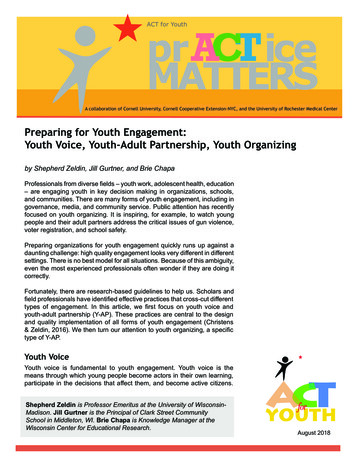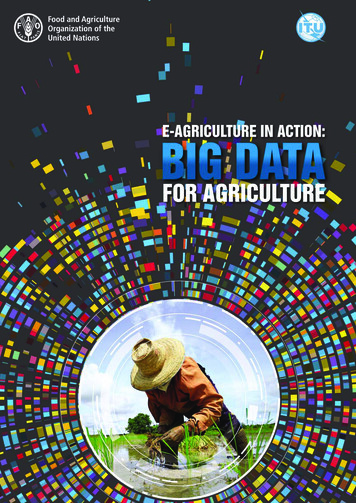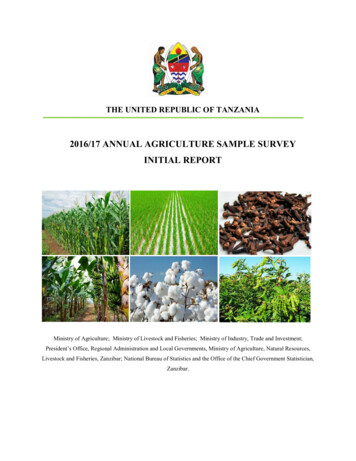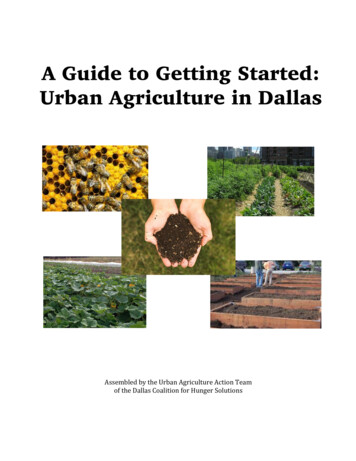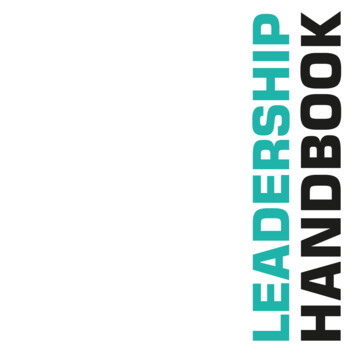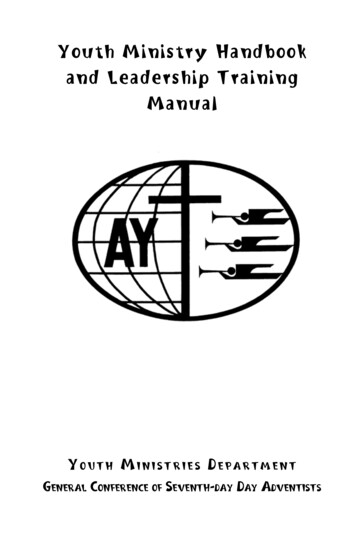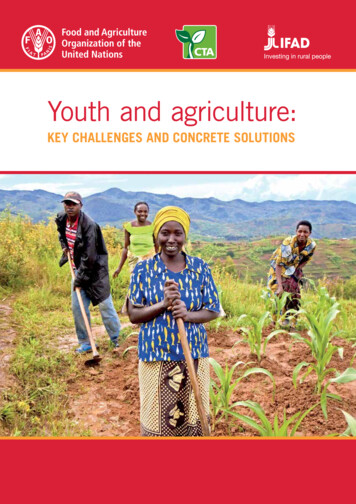
Transcription
Youth and agriculture:key challenges and concrete solutions
Youth and agriculture:Key challenges and concrete solutionsPublished by the Food and Agriculture Organization of the UnitedNations (FAO) in collaboration with the Technical Centre for Agriculturaland Rural Cooperation (CTA) and the International Fund for AgriculturalDevelopment (IFAD)
The designations employed and the presentation of material in this publication do not imply theexpression of any opinion whatsoever on the part of the Food and Agriculture Organization ofthe United Nations (FAO) ), the Technical Centre for Agricultural and Rural Cooperation (CTA) orthe International Fund for Agricultural Development (IFAD) concerning the legal or developmentstatus of any country, territory, city or area or of its authorities, or concerning the delimitationof its frontiers or boundaries. The mention of specific companies or products of manufacturers,whether or not these have been patented, does not imply that these have been endorsed orrecommended by FAO, CTA or IFAD in preference to others of a similar nature that are notmentioned. The views expressed herein are those of the authors and do not necessarily representthose of FAO, CTA or IFAD.This publication contains opinions of and statements by various information providers. FAO, IFADand CTA do not represent or endorse the accuracy or reliability of any opinion, statement or otherinformation provided by any information provider.This publication contains links and references to third-party Web sites. The linked sites are notunder the control of FAO, IFAD and CTA and FAO, IFAD and CTA are not responsible for thecontent of any linked site.(FAO) ISBN 978-92-5-108475-5(FAO) E-ISBN 978-92-5-108476-2 (PDF)(CTA) ISBN 978-92-9081-558-7 FAO, 2014FAO encourages the use, reproduction and dissemination of material in this information product.Except where otherwise indicated, material may be copied, downloaded and printed for private study,research and teaching purposes, or for use in non-commercial products or services, provided thatappropriate acknowledgement of FAO as the source and copyright holder is given and thatthe FAO’s endorsement of users’ views, products or services is not implied in any way.All requests for translation and adaptation rights, and for resale and other commercial use rightsshould be made via www.fao.org/contact-us/licence-request or addressed to copyright@fao.org.FAO information products are available on the FAO website (www.fao.org/publications) and canbe purchased through publications-sales@fao.org.The resources used by FAO for this document have beenprovided by the Swedish International DevelopmentCooperation Agency (Sida). Sida does not necessarily share theviews expressed in this material. Responsibility for its contentrests entirely with the authors.Cover photo: IFAD/Susan Beccioii
ContentsForewordAcknowledgmentsExecutive summaryAcronymsIntroduction1. Access to knowledge, information and educationvviiixxixvii11.1 Introduction21.2 Case studies41.2.3.4.5.6.7.8.9.Agri-enterprise development and managementRebranding agriculture in schoolsYoung Women Open SchoolsOn-the-job trainingPhD training in agricultureDistance learning for young farmersICTs for extension servicesICT solutions for agricultureYouth resource centres on agriculture45679101113151.3 Conclusions162. Access to land192.1 Introduction202.2 Case studies2110.11.12.13.14.15.16.Land tenure, farm productivity and enterprise developmentLand ownership for shea butter producersDistributing hillside land to landless youthYoung rural entrepreneur and land fund programmeReclaiming desert land for young graduatesSmall landlords and large tenants programmeShort-term land leases for youth2.3 Conclusions3. Access to financial services2123242426282830333.1 Introduction343.2 Case studies3517.18.19.20.21.22.23.24.25.Installation aidPublic-private investment fundYouth Venture Capital FundYouth socio-economic empowerment serviceFinancial services for youth through rural entrepreneurshipFriends Help Friends Saving GroupLoan project for young entrepreneursCrowd-funding: The goat dairy projectFinance and mentorship for innovative young social entrepreneurs3.3 Conclusions35373838394042434445iii
4. Access to green jobs494.1 Introduction504.2 Case studies5126.27.28.29.30.31.32.Junior Farmer Field and Life School programmeVocational training in small biogas companiesVocational training for young beekeepersGreen jobs apprenticeship programmeRaising youth’s awareness of organic agricultureAgro-ecotourism businessTransforming water hyacinth into paper515253545557594.3 Conclusions605. Access to markets635.1 Introduction645.2 Case studies6533.34.35.36.37.38.39.Connecting farmersInnovation in distribution and salesLinking producers and consumersCertifying social youth businessMilk and dairy processingInnovative models for young coffee producersIndependent business born from the commitment of youth5.3 Conclusions6. Engagement in policy dialogue6666686970717273776.1 Introduction786.2 Case studies7940.41.42.43.44.45.46.47.Young farmers’ representationThe African Union listening to youthDocumenting youth policies and initiativesYouth peasant federationEchoing the voices of YouthYouth caring about the environmentThe European Council of Young FarmersYPARD – Young Professionals’ Platform for Agricultural Researchfor Development6.3 Conclusions7981828484858788897. Overall conclusions91References97Annex I: Survey ‘Youth and agriculture: key challenges and concrete solutions’ 101iv
ForewordRural youth are the future of food security. Yet around the world, few young people see a future forthemselves in agriculture or rural areas.Rural youth face many hurdles in trying to earn a livelihood. Pressure on arable land is high in many partsof the world, making it difficult to start a farm. Youth often also lack access to credit, and many otherproductive resources necessary for agriculture. But even if such hurdles can be overcome, isn’t urban lifemuch cooler? Perhaps, but not if you cannot make a living there. Particularly in developing countries, ruralyouth find themselves in such a bind.While most of the world’s food is produced by (ageing) smallholder farmers in developing countries,older farmers are less likely to adopt the new technologies needed to sustainably increase agriculturalproductivity, and ultimately feed the growing world population while protecting the environment.Hence, we need to re-engage youth in agriculture. Can this be done?This publication provides real life examples of how this can be done. It shows how tailor-madeeducational programmes (such as the Junior Farmer Field and Life Schools approach) can providerural youth with the skills and insights needed to engage in farming and adopt environmentallyfriendly production methods. With some additional effort, through farmer organizations and improvedinfrastructure, young farmers can connect to markets to sell their often higher value food. Facilitatingyouth’s access to credit helps them become entrepreneurs, improving their self-esteem and the feelingthat they can make a living in rural areas.None of this will come easily. There are no silver bullets. However, the large number of successfulinitiatives presented in this study offer a sense of hope. There are workable solutions to overcomethe challenges faced by young women and men trying to engage in agriculture and earn a living inrural areas. Many of the initiatives reported in this study originate with the youth themselves. Theseinitiatives show that – when there is a supportive environment – youth are able to find innovativeways to create a future for themselves, and also contribute to the societies and communities in whichthey live.We hope that this publication will help development practitioners, youth leaders, youth associations,producers’ organizations and policy makers alike by providing insights into possible solutions that canbe tailored to their own context.This study has been a joint undertaking of the Food and Agriculture Organization of the UnitedNations (FAO), the International Fund for Agricultural Development (IFAD) and the Technical Centrefor Agricultural and Rural Cooperation (CTA). We are most grateful to our staff for their initiative andcontributions in putting together this compilation of good practices, and for showing us the lessons weall should draw from those experiences.Rob Vos, Director of the Social Protection Division of FAO (ESP)Xiangjun Yao, Director of the Climate, Energy and Tenure Division of FAO (NRC)Marcela Villarreal, Director of the Office for Communication, Partnerships and Advocacy of FAO (OPC)Adolfo Brizzi, Director of Policy and Technical Advisory Division of IFAD (PTA)Lamon Rutten, Manager PMI (CTA)v
AcknowledgmentsThe preparation of Youth and agriculture: key challenges and concrete solutions was possiblethanks to the valuable contributions of individuals, divisions and organizations, and their inputsare gratefully acknowledged. The publication was prepared by staff of the Climate, Tenure andEnergy Division (NRC), the Social Protection Division (ESP) and the Office for Partnerships,Advocacy and Capacity Development (OPC) of FAO; the Agriculture, Rural Development andYouth in the Information Society of CTA; and the Programme Management Department (PMD)and the Technical Advisory Division (PTA) of IFAD. Overall guidance was provided by NoraOurabah Haddad (OPC), Bernd Seiffert (ESP), Reuben Sessa (NRC) and Rosalud de La Rosa(OPC) from FAO; Anne-Laure Roy from IFAD; and Ken Lohento from the ARDYIS projectof CTA. The chapters on access to knowledge, information and education; access to land; andengagement in policy dialogue were prepared by Charlotte Goemans (FAO–OPC). The chapterson access to financial services and access to markets were prepared by Francesca Dalla Valle(FAO–ESP), Alessandra Giuliani and Martina Graf from the Bern University of Applied Sciences,School for Agricultural, Forest and Food Sciences (HAFL), and Charlotte Goemans. The chapteron access to green jobs was prepared by Tamara van ‘t Wout (FAO–NRC).The following FAO colleagues provided information on FAO’s youth work and/or providedcomments on the publication: Olivio Argenti, Ida Christensen, Eve Crowley, Rosalud de la Rosa,Ana Paula de la O Campos, Nicoline De Haan, Eric Demafeliz, Francesca Distefano, Farid ElHaffar, Valentina Franchi, Boris Gandon, Alashiya Gordes, Nandini Gunewardena, MitchellHall, Mirela Hasibra, Malcolm Hazelman, Susan Kaaria, Daniela Kalikoski, Regina Laub,Sharon Lee Cowan, Erdgin Mane, Raffaele Mattioli, Katia Meloni, Valeria Menza, Calvin Miller,Jamie Morrison, Shirley Mustafa, Olga Navarro, Courtney Paisley, Hajnalka Petrics, GeorgeRapsomanikis, Mariagrazia Rocchigiani, Nicholas Ross, Makiko Taguchi, Rob Vos, Peter Wobst,Andrea Woolverton and James Zingeser.The following IFAD colleagues provided information on IFAD’s youth work and/or providedcomments on the publication: Abdelhamid Abdouli, Hubert Boirard, Hawa Bousso, AmadouDaouda Dia, Ambra Gallina, Beatrice Gerli, Ameth Hady Seydi, Michael Hamp, Nabil Mahaini,Norman Messer, Luyaku Nsimpasi, Elaine Reinke, Philippe Rémy, Momodu Sesay, MohamedShaker Hebara and David Suttie. Boris Gandon, Enrique Nieto from FAO and NawsheenHosenally from CTA contributed to the selection and write-up of the examples.The following CTA colleagues provided inputs on CTA’s work on youth and on the selection ofcase studies: Judith Francis, Jose Filipe Fonseca, Olu Ajayi, and Nawsheen Hosenally from theARDYIS project (who contributed in addition to editing some stories). Clare Pedric (Consultant)drafted some initial articles and other inputs were shared by some CTA contacts including AnjuMangal, Miriama Kunawave Brown, Horace Fisher, Nomvula Dlamini, Diana Francis, Alex Njeru,Tukeni Obasi, Sithembile Ndema Mwamakamba and Gregg Rawlins.The team benefited greatly from the information submitted by the respondents to the online surveyand in particular by Maria Elenice Anastácio, Francis Xavier Asiimwe, Raynard Burnside, AurélieCharrier, Magali Delomier, Franck Devort, Pavlos Georgiadis, Sophia Hellmayr, Ben Hillman,Wen-Chi Huang, Zernash Jamil, Robert Kibaya, Saing Koma Yang, Mariam Mansa Camara,vii
Michael McVerry, Milla Menga, Mireille Moko, Edward Mukiibi, Kakha Nadiradze, Sourou HervéAppolinaire Nankpan, Anaclet Ndahimana, Moses Nganwani Tia, Marceline Ouedraogo, RomainOuedraogo, Sopheap Pan, Pramesh Pokharel, Pascale Rouhier, Jean-Claude Sabushimike, AmethHady Seydi, Natalia Skupska, Tola Sunmonu, Sherman Tang, Kok Tha, Eloï Toi Tegba, Tong ChanTheang, Karen Tuason and Albert Yeboah Obeng.The co-publishing agreement was arranged with the support of Bruce Frederick Murphy and DanilaRonchetti from IFAD; Lisa Pace, Marta Pardo and Rachel Tucker from FAO; and Jenessi Matturifrom CTA. Final editing was done by Ruth Duffy, and layout and design by Suzanne Redfern andFabrizio Puzzilli.viii
Executive summaryGlobal population is expected to increase to 9 billion by 2050, with youth (aged 15–24) accountingfor about 14 percent of this total. While the world’s youth cohort is expected to grow, employmentand entrepreneurial opportunities for youth – particularly those living in developing countries’economically stagnant rural areas – remain limited, poorly remunerated and of poor quality. Inrecognition of the agricultural sector’s potential to serve as a source of livelihood opportunitiesfor rural youth, a joint MIJARC/FAO/IFAD project on Facilitating Access of Rural Youth toAgricultural Activities was carried out in 2011 to assess the challenges and opportunities withrespect to increasing rural youth’s participation in the sector. Over the course of the project,six principal challenges were identified. For each challenge, this publication presents a series ofrelevant case studies that serve as examples of how this challenge may be overcome.The first principal challenge identified is youth’s insufficient access to knowledge, informationand education [Chapter 1]. Poor and inadequate education limits productivity and the acquisitionof skills, while insufficient access to knowledge and information can hinder the development ofentrepreneurial ventures. Particularly in developing countries, there is a distinct need to improveyoung rural women’s access to education, and to incorporate agricultural skills into rural educationmore generally. Agricultural training and education must also be adapted to ensure that graduates’skills meet the needs of rural labour markets. Case studies from Cambodia, Uganda, Saint Lucia,Pakistan, Madagascar, Brazil, Ghana, Kenya, Rwanda and Zambia illustrate innovative ways ofmaking this happen.The second challenge identified during the project is youth’s limited access to land [Chapter 2].Although access to land is fundamental to starting a farm, it can often be difficult for young peopleto attain. Inheritance laws and customs in developing countries often make the transfer of land toyoung women problematic, and so are in need of amendment. Loans to assist youth in acquiringland are also needed, while leasing arrangements through which youth gain access – though notownership – to land may also prove effective. Case studies from the Philippines, Burkina Faso,Ethiopia, Mexico, Egypt and Uganda all highlight possible means of improving youth’s access toland.Inadequate access to financial services [Chapter 3] was identified as the third principal challenge.Most financial service providers are reluctant to provide their services – including credit, savingsand insurance – to rural youth due to their lack of collateral and financial literacy, among otherreasons. Promoting financial products catered to youth, mentoring programmes and start-upfunding opportunities can all help remedy this issue. Encouraging youth to group themselvesinto informal savings clubs can also prove useful in this respect. Case studies from France,Canada, Uganda, Moldova, Senegal, Cambodia, Bangladesh and Grenada all offer examples forpolicymakers and development practitioners of how rural youth’s access to financial services canbe improved.Difficulties accessing green jobs [Chapter 4] was identified as the fourth challenge to strengtheningyouth’s involvement in agriculture. Green jobs can provide more sustainable livelihoods in thelong run, and can be more labour intensive and ultimately involve more value added. However,rural youth may not have the skills (or access to the necessary skills-upgrading opportunities) topartake in the green economy. Improving youth’s access to education and training – includingix
formal and informal on-the-job training – is needed to redress this skills mismatch. Case studiesfrom the Zanzibar Archipelago, Rwanda, China, the United States, Bahamas, Kenya and Ugandaall illustrate innovative ways of improving youth’s access to the skills and opportunities needed togenerate green jobs in agriculture.The fifth principal challenge identified was young people’s limited access to markets [Chapter 5], aswithout such access youth will not be able to engage in viable and sustainable agricultural ventures.Access to markets for youth is becoming even more difficult due to the growing international influenceof supermarkets and the rigorous standards of their supply chains. Young rural women in developingcountries face additional constraints in accessing markets, due in part to the fact that their freedomof movement is sometimes limited by cultural norms. Improving access to education, training andmarket information can all facilitate youth’s access to markets, with niche markets offering particularlysignificant opportunities for young farmers. Facilitating their involvement in (youth) producers’groups can be similarly beneficial in this respect. Case studies from Kenya, Ghana, southern Europe,the United States, Tanzania, Colombia and Benin all offer examples of how youth’s access to marketscan be improved.The sixth challenge identified was youth’s limited involvement in policy dialogue [Chapter 6].Too often young people’s voices are not heard during the policy process, and so their complex andmultifaceted needs are not met. Policies often fail to account for the heterogeneity of youth, and so donot provide them with effective support. To remedy this, youth need the requisite skills and capacitiesfor collective action to ensure that their voices are heard. Policymakers themselves must also activelyengage youth in the policymaking process. Case studies from Togo, Nepal and Brazil, as well asregional-level examples from Africa and Europe, all highlight ways to involve youth in shaping thepolicies that most affect them.Addressing these six principal challenges will prove vital to increasing youth’s involvement in theagricultural sector, and ultimately addressing the significant untapped potential of this sizeable andgrowing demographic. In developing countries in particular, facilitating the youth cohort’s participationin agriculture has the potential to drive widespread rural poverty reduction among youths and adultsalike. While these challenges are complex and interwoven, a number of key conclusions can be drawnfrom the case studies: ensuring that youth have access to the right information is crucial; integratedtraining approaches are required so that youth may respond to the needs of a more modern agriculturalsector; modern information and communications technologies offer great potential; there is a distinctneed to organize and bring youth together to improve their capacities for collective action; youthspecific projects and programmes can be effective in providing youth with the extra push needed toenter the agricultural sector; and a coherent and integrated response is needed from policymakersand development practitioners alike to ensure that the core challenges faced by youth are effectivelyaddressed. Indeed, a coordinated response to increase youth’s involvement in the agricultural sector ismore important than ever, as a rising global population and decreasing agricultural productivity gainsmean that youth must play a pivotal role in ensuring a food-secure future for themselves, and for futuregenerations.x
AcronymsAASCAnnual Agro-eco-tourism Summer Camp (Bahamas)ABEDAdvanced Beekeeping Enterprise Development (Tibet)ACEAudio Conferencing for ExtensionACPAfrica, Caribbean and Pacific Group of StatesAEDMAgri-Enterprise Development and Management Programme (Cambodia)AESAAgro-ecosystem analysisAGRAAlliance for a Green Revolution in AfricaAIDSAcquired immunodeficiency syndromeAMRSPAssociation of Major Religious Superiors of the PhilippinesANPEAgence Nationale pour l’EmploiANPFaAll Nepal Peasants’ FederationARDAgriculture and rural developmentASSPAgricultural Services Support Programme (Zanzibar)ASYSongtaab-YalgreAUAfrican UnionBOADWest African Development BankCAADPComprehensive Africa Agriculture Development ProgrammeCAFYCaribbean Agricultural Forum for YouthCAICommunity Agricultural InformationCANCitizen Action Net for Social Development (Cambodia)CAPCommon Agricultural PolicyCARPComprehensive Agrarian Reform Program (Philippines)CBOCommunity-based organizationCBUCoffee business unit (Colombia)CCIConscious Capitalism InstituteCEDACCambodian Center for Study and Development in AgricultureCEJAEuropean Council of Young FarmersCGIARConsultative Group on International Agricultural ResearchCMCSGCommunity Management Course Saving Group (Cambodia)CNJNational Youth CouncilCOATaiwan Council of AgricultureCOM-VIDAsCommissions for the Environment and Quality of Life (Brazil)CONTAGNational Confederation of Agricultural workers (Brazil)COONAFATTogolese national cooperative for the pineapple value chainCOPConference of the Partiesxi
xiiCSACommunity Supported Agriculture (China)CSOsCivil Society OrganizationsCTATechnical Centre for Agricultural and Rural CooperationCTOPTogolese Coordination Committee of Farmers Organizations and AgriculturalProducersCUZACooperative Union of ZanzibarCYOPCommunity Youth Outreach Program (Bahamas)CYTSCAN Youth Team Saving Group (Cambodia)DADevelopment agencyDAADGerman Academic Exchange ServiceDISCDeveloping Innovations in School Cultivation (Uganda)ESPSocial Protection Division (FAO)ESWGender, Equity and Rural Employment Division (FAO)ETTIEastern Tibet Training InstituteEUEuropean UnionFAOFood and Agriculture Organization of the United NationsFARNPANFood, Agriculture and Natural Resources Policy Analysis NetworkFFSFarmer Field SchoolFHFFriends Help Friends saving group (Cambodia)FIBAFarm In Bytes ApplicationFIRAInvestment Fund for the Future of Agriculture (Canada)FNNFarmer and Nature NetFNPEEJFonds National pour la Promotion de l’Entreprise et de l’Emploi des Jeunes (Benin)FRAQQuebec Young Farmers’ FederationFSFFriendship Saving Federation (Cambodia)FSPFinancial service providerFTJERYoung Rural Entrepreneur and Land Fund Programme (Mexico)GCARDGlobal Conference on Agricultural Research for DevelopmentGFARGlobal Forum on Agricultural ResearchGHGGreenhouse gasGKPGlobal Knowledge PartnershipGRETGroup for Research and Exchange of TechnologyGTETGreen Technology and Eco-Tourism (Tibet)GYINGlobal Youth Innovation NetworkHAFLBern University of Applied Sciences, School for Agricultural, Forest and FoodSciencesHIVHuman immunodeficiency virusHOOPSSHelping Out Our Primary and Secondary Schools Project (Saint Lucia)ICTInformation and communications technology
IFADInternational Fund for Agricultural DevelopmentIFPRIInternational Food Policy Research InstituteIICAInternational Institute for Cooperation on AgricultureIIEDInternational Institute for Environment and DevelopmentIPMIntegrated pest managementIPRCIntegrated Polytechnic Regional Centre (Rwanda)ITCInternational Trade CentreJFFLSJunior Farmer Field and Life SchoolJICAJapan International Cooperation AgencyKDOKissan Dost Organization (Pakistan)KFBGKadoorie Farm and Botanic GardenKICKKisumu Innovation Centre KenyaKWAKissan Welfare Association (Pakistan)KWCKhawateen Welfare Council (Pakistan)LSGLadies Saving Group (Cambodia)MECMicroenterprise creditMFIMicrofFinance instituteMIJARCInternational Movement of Catholic Agricultural and Rural YouthMORDIMainstreaming of Rural Development InnovationsNAJKDutch Agricultural Youth OrganisationNAYANational Association of Youth in Agriculture (Dominica)NDBPNational Domestic Biogas Programme (Rwanda)NFCPNational Federation of Coffee Producers (Colombia)NFFNational Farmers Forum (Togo)NGONon-governmental OrganizationNRCClimate, Energy and Tenure Division (FAO)NYRCNdola Youth Resource Centre (Zambia)OASOrganization of American StatesOPCOffice for Partnerships, Advocacy and Capacity Development (FAO)PAEIProgramme d’Appui à l’Emploi Indépendant (Benin)PAFPNETPacific Agricultural and Forestry Policy NetworkPCDPartnerships for Community Development (China)PMDProgramme Management Department (IFAD)PROMER IIProject for the Promotion of Rural Entrepreneurship II (Senegal)PROPACSubregional Platform of Peasant Organizations of Central AfricaPTAPolicy and Technical Advisory Division (IFAD)REJEPPATNetwork of young producers and agricultural professionals of TogoRESTRelief Society of Tigray (Ethiopia)RMERural microenterprisexiii
ROPPANetwork of Peasant Farmers’ and Agricultural Producers’ Organisations ofWest AfricaRUFORUMRegional Universities Forum for Capacity Building in AgricultureRULRivall Uganda LimitedSACCOSavings and credit cooperativeSAFIRSupport Service to Rural FinanceSFYNSlow Food Youth NetworkSGLSolidarity group lendingSHGSelf-help groupSLAFYSaint Lucia Agriculture Forum for YouthSMESmall and medium enterpriseSNVThe Netherlands Development OrganisationSOFSaving for Our Future (Cambodia)SPCPacific CommunitySYFNSavannah Young Farmers Network (Ghana)TFMTask Force Mapalad (Philippines)TIC AmericasTalent and Innovation Competition of the AmericasTRFTaiwan Rice Farmers Co. LtdTRNThai Rural NetTVETTechnical and vocational education and trainingUEMOAEconomic and Monetary Union of West AfricaUNUnited NationsUNEPUnited Nations Environment ProgrammeUNESCOUnited Nations Educational, Scientific and Cultural OrganizationUN-HABITAT United Nations Human Settlements ProgrammexivUNICEFUnited Nations Children’s FundUNRWAUnited Nations Relief and Works Agency for Palestine Refugees in the Near EastUPAQuebec Union of Agricultural ProducersUSAIDUnited States Agency for International DevelopmentVC4AVenture Capital for AfricaVSLASVillage savings and loan associationsWBWorld BankWDAWorkforce Development AuthorityWFPWorld Food ProgrammeWHCWomen’s household creditWHOWorld Health OrganizationWOSWomen Open School (Pakistan)WWFWorld Wide Fund for NatureYABTYoung Americas Business TrustYEDFYouth Enterprise Development Fund (Kenya)
YEFYouth Entrepreneurship FacilityYELPYouth Entrepreneur Loan Project (Bangladesh)YESYouth Entrepreneurship and SustainabilityYFFYouth For Future Saving Group (Cambodia)YoBloCoYouth in Agriculture Blog CompetitionYPARDYoung Professionals’ Platform for Agricultural Research for DevelopmentYPFYouth Peasants FederationYSEEPYouth Socio-Economic Empowerment Project (Republic of Moldova)YSEIYouth Social Entrepreneur InitiativeYSLYouth start-up loanYVPYouth Volunteerism Program (Bahamas)xv
IntroductionGlobal population is projected to reach 9 billion by 2050. The number of young people (aged15 to 24) is also expected to increase to 1.3 billion by 2050, accounting for almost 14 percent ofthe projected global population. Most will be born in developing countries in Africa and Asia,where more than half of the population still live in rural areas (UNDESA, 2011). Rural youthcontinue to face challenges related to unemployment, underemployment and poverty. Despitethe agricultural sector’s ample potential to provide income-generating opportunities for ruralyouth, challenges related specifically to youth participation in this sector – and, more importantly,options for overcoming them – are not extensively documented. Furthermore, statistics on ruralyouth are often lacking, as data are rarely disaggregated by important factors such as age, sex andgeographical location.A joint Mouvement international de la jeunesse agricole et rurale catholique (MIJARC/IFAD/FAO) project on Facilitating Access of Rural Youth to Agricultural Activities was carried out in2011 to address this information gap and to take a closer look at the challenges that rural youthface while engaging in agriculture. The agricultural sector is seen as crucial to addressing thedisproportionately high levels of youth unemployment, underemployment and poverty. Not onlyis the sector of vital importance to rural economies worldwide – and particularly in developingcountries – it also possesses significant untapped development and employment creation potential.To help seize this potential, the project engaged rural youth informants from all over the world toidentify a core set of challenges that should be overcome for youth to create or seize decent workopportunities1 in rural areas and to reverse the rural exodus. Within the framework of the project,steps were taken to explore examples (MIJARC/IFAD/FAO, 2012) showing how one or more ofthese core challenges were successfully addressed.The findings of the joint project showed the need to further document the challenges that youthface while engaging in agriculture. The present publication was initiated in response to the requestfrom rural youth representatives involved in the project to further document examples on youthengagement in the agricultural sector to identify potential solutions to overcome these challenges.The publication is the result of a strategic partnership between the Food and AgricultureOrganization of the United Nations (FAO),2 the Technical Centre for Agricultural and RuralCooperation (CTA) and the International Fund for Agricultural Development (IFAD). These threeorganizations joined forces to share their respective strengths, contacts an
Youth and agriculture: Key challenges and concrete solutions Published by the Food and Agriculture Organization of the United Nations (FAO) in collaboration with the Technical Centre for Agricultural
